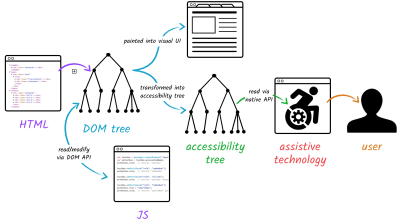
Olademiji Gideon
 ARIA attributes, WAI-ARIA, web accessibility, accessible web development, ARIA roles and states, semantic HTML vs ARIA, ARIA best practices
ARIA attributes, WAI-ARIA, web accessibility, accessible web development, ARIA roles and states, semantic HTML vs ARIA, ARIA best practices
 1 comment
1 comment
 20 Aug, 2025
20 Aug, 2025

Accessibility isn’t just a checkbox it’s a commitment. ARIA (Accessible Rich Internet Applications) attributes help align our code with that commitment, but only when used purposefully and ethically. Let’s dive deep skills, references, and visuals at the ready.
ARIA is a specification by the W3C (World Wide Web Consortium) enhancing the accessibility of dynamic web content especially when native HTML falls short. It adds semantic context roles, states, and properties so assistive technologies like screen readers can interpret custom interfaces accurately.
role="button")aria-expanded="true")aria-labelledby="id").Best practices insist:
Examples include button, navigation, progressbar, alert — essential for screen readers to understand UI behavior.
aria-expanded, aria-checked, aria-selected, aria-hidden, and more.
Some attributes, like aria-hidden or aria-label, apply to any element.
These rules help us double-check: Are we adding real value or just noise?
Screen readers have no clue what this is.
Patterns: Landmarks, Live Regions, and Dynamic Widgets
Skeptical View: When ARIA Can Go Wrong
Think of a website like a big playground. Some kids can see everything on the playground, but some kids can’t see well they need someone to tell them what’s around.
That “someone” is a screen reader (it reads the playground out loud).
Now, ARIA attributes are like little sticky notes you put on the playground equipment to explain what they are for, so everyone can enjoy it.
For example:
• aria-label="Swing" → It’s like putting a sticker on the swing that says “This is a swing!” so kids who can’t see know it’s a swing.
• aria-hidden="true" → It’s like covering something up and saying “Don’t tell the blind kids about this, it’s not important.”
• aria-expanded="true" → It’s like telling them “This box is open right now!” or “Nope, it’s closed!”
So, ARIA attributes are special helpers that whisper extra information to screen readers, making sure no kid is left out of the playground fun.
In Conclusion
Adopting ARIA is forward-thinking, but only if paired with intentional, questioning use. Every attribute should enhance clarity for users relying on assistive tech not just serve as a dev convenience.
Olademiji Gideon
1 comment
Olademiji Gideon
20 Aug, 2025 at 10:42 AM
cool stuff